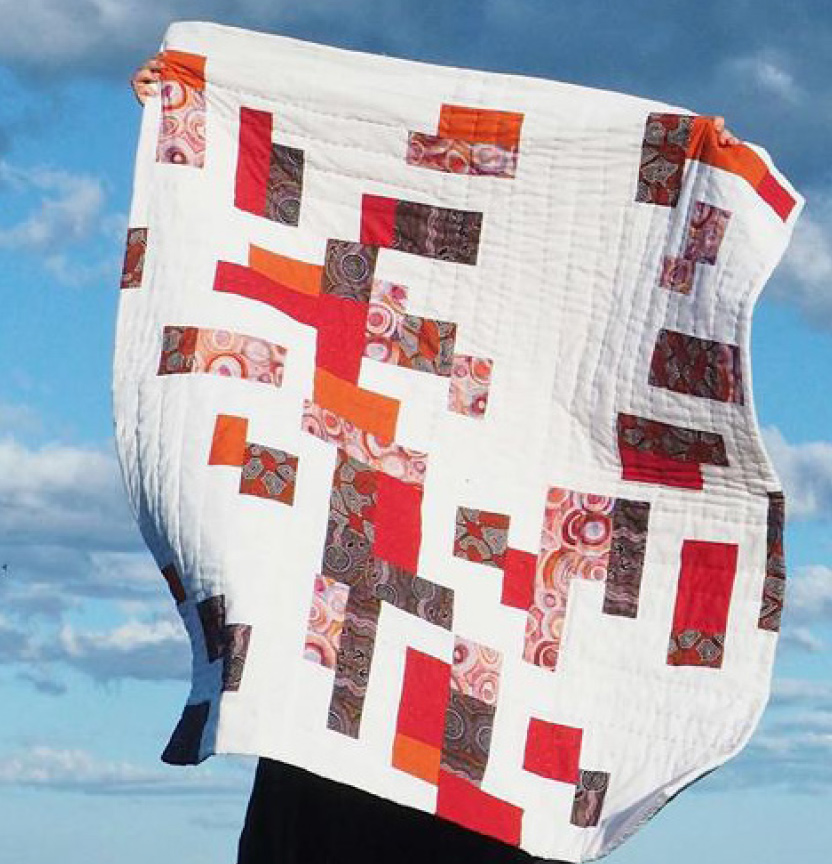 | ||
| Your browser is not supported. | ||
|
Please browse our site using any of the following options:
| ||
'Outside The Lines' By Ellie Beck

LEVEL: EASY
WHAT YOU'LL NEED:
Fabrics used:
- Warlu Water Dreaming (brown) #9330458462633
- Maureen Women Travelling Dreaming #9330458409416
- DRL Agnes Nampajimpa (brown) #9330458497529
- Prima Homespun solid in Pumpkin (112cm)
- Prima Homespun solid in Brick Red (112cm)
- Prima homespun solid in White (112cm wide)
- Quilt backing Linen Look grey, dark (290cm wide)
- Hand quilted with Perle 8 cotton in Colour #223 (dusty rose) and #823 (dark blue)
- Wadding Bamboo / cotton 228cm wide
Finished quilt size is approx. 100cm x 120cm
INSTRUCTIONS
This quilt is a combination of a pattern and improvisational quilting process- a merging of both pattern and instinctual creation. This an excellent way to step into improv quilting if you've never tried it before. If you're already working in an improv style, you might like this way of mixing the two together.
Using 5 feature fabrics (2x solid colours and 3x prints), white background fabric, and backed with grey grid quilt backing fabric, the quilt is made up of 12 blocks in total - 3 wide x 4 long. Each block is approx. 32cm. There are also some white strips between the blocks at different intervals (see diagrams).
With 2 different block designs this quilt was made using 6 of each block, but you could make your quilt out of any combination, i.e. 5 x Block A and 7 x Block B. This is the where the fun improvisational aspect of this quilt comes into play.
You will also notice that the placement of each feature fabric is different for each block. Play around with layouts and create your own block patterns. You can pre-plan this, or simply pick up and sew as you're going.
Please note: ¼" seam allowances used.
Iron as needed at each step, making sure that all seams face towards the coloured feature blocks where possible.
DO NOT trim or cut your blocks until you have finished them all and ironed well.
Total fabric needed:
As 5 feature prints are being used in this quilt, below quantities allocate more fabric than you will need. This means that you can arrange the prints around the quilt as you want, rather than having each block in the same pattern placement. You'll use some of the extra fabric for the backing, but you could also make a pillow. Or alternatively use it to make your quilt bigger.
- 5x feature fabrics 112cm wide @ 30cm each
- White fabric 112cm wide @ 1.5m
- Backing 270cm @ 70cm
- Wadding 100cm @1.2m
To begin you'll need to:
- Cut each feature fabric at 10cm, 10cm and 7cm WOF. Do this by laying all 5 pieces on top of each.
- Cut white:
a. {Block A} 2 strips WOF @10cm and 4 strips WOF @ 7cm
b. {Block B} 6 strips WOF @ 10cm
c. {Insert blocks} 2 strips WOF @ 10cm
Tip: Cut and sew Block A before Block B, to make the process easier.
Block A:
Feature Fabric (3x prints and 2x solids)
You will need:
10cm x 10cm @ 12 qty {piece 1 + piece 8}
10cm x 17cm @ 12 qty {piece 9 + piece 11}
10cm x 7cm @ 6qty {piece 5}
Cut:
- Lay all 5 feature fabrics on top of each other. Make 2 cuts @17cm, 2 @ 10cm, 1 @ 7cm. You'll have 5 qty of 10cm x 7cm, 10 qty of 10cm x 10cm, 10 qty of 10cm x 17cm
- Separate feature fabrics and cut 2 different prints @ 7cm, 3 @ 10cm, 3 @ 17cm. Cut more pieces than needed so that you can mix it up a bit, without having all the same pieces in each block. Save the extra pieces left over for Block B, or for the backing feature
White:
You will need:
10cm x 7cm @6qty {piece 2}
7cm x 16cm @ 12qty {piece 3 + piece 4}
7cm x 24cm @ 6qty {piece 7}
10cm x 16cm @12qty {piece 6 + piece10}
Cut:
- Lay 2 qty of 10cm strip on top of each other. Cut at 17cm intervals = 12 qty of 10cm x 17cm {pieces 6 & 10}. You'll have 1qty of 10cm x 7cm
- Lay 2 qty of 7cm strips on top of each other. Cut at 16cm intervals = 12 qty of 7cm x 16cm {pieces 3 & 4}. You'll have 1 qty of 7cm x 10cm
- Lay 2 qty of 7cm strips on top of each other. Cut 3 x 24cm, 3 x 10cm. You'll have 6 qty of 7cm x 24cm and 7cm x 10cm
- Save any extra for Block B
Sew:
- Using string piecing, join #1 to #2, join #5 to #6, #8 to #9, and #10 to #11. Snip to separate.
- Using the diagram, sew piece #1/2 to piece #3, piece #1/2/3 to piece #4, piece #1/2/3/4 to #5/6 and so forth until all pieces are sewn to create one block.
- Continue with all other pieces to make 6x Block A. Remember as you're sewing to check that you're happy with the way that the feature fabrics are placed within each individual block. Make all the blocks a different layout with the feature pieces, have fun with this, you don't need to over plan the ordering.
- Iron all blocks well, making sure that seams are pressed to the feature prints where possible.
- Trim each block to approx. 32cm x 32cm.
- Set aside while we sew Block B
Block B:
Feature Fabric (3 x prints and 2 x solids)
You will need:
10cm x 10cm @ 6qty {piece 2}
7cm x 17cm @6qty {piece 4}
10cm x 7cm @ 6qty {piece 6}
10cm x 12cm @ 6qty {piece 7}
Cut:
- Lay 5 feature pieces @ 10cm on top of each other. Make a cut @ 10cm, 12cm and 7cm. You will have 5 qty of 10cm, 12cm and 7cm.
- Separate fabrics and cut 2 of different prints at 10cm, 12cm and 7cm.
- Lay 5 features pieces @ 7cm on top of each other. Make 2 cuts @ 17cm. You will have 6 qty of 17cm x 7cm, with left over fabrics for backing feature.
White Fabric:
You need 6qty of each:
10cm x 17cm {piece 1}
10cm x 7cm {piece 3}
10cm x 26cm {piece 5}
10cm x 12cm {piece 8}
10cm x 32cm {piece 9}
Cut:
- Lay 3 x 10cm strips of white on top of each other. Make a cut at 32cm, 26cm, 17cm, 13cm, 7cm. Repeat with 3 more @10cm strips WOF. You will have 6qty 10cm x 32cm, 10cm x 17cm, 10cm x 12cm, 10cm x 26cm, 10cm x 7cm
Sew:
- Using string piecing join #1 to #2, #3 to #4, #6 to #7 to #8.
- Using the diagram sew #1/2 to #3/4 to #5 to #6/7/8.
- Sew this block to #9
Quilt Top:
Cut your inset white pieces to:
1 qty 10cm x 65cm
2 qty 10cm x 35cm
Arrange your blocks into a 3 x 4 grid. Move them around to see how the colours and patterns best fit. Use your instinct to know when it looks good, perhaps a pleasant blend when two patterns overflow into each other (i.e. they find themselves sitting side-by-side in two different blocks). Do consider the amount of white - negative - space and how this works with the flow of the overall quilt.
Insert your white pieces as well. You can use the diagram as an example or use them to break up some colour blocks.
Sew all blocks together to make your quilt top. Iron well and trim edges so your quilt top is 110cm x 130cm.
Backing:
If you would like you quilt backing to have little colour and pattern details from the front, you can use the extra pieces here to make some strips of backing amongst the grey.
This quilt was backed using 2 strips @ 7cm and 1 strip @10cm, using grey and piecing together any feature colours make 120cm pieces.
Cut backing fabric into 3 pieces and arranged the strips within these:
2 feature strips @ 7cm
1 feature strip @ 10cm
3 Grey (backing) @ 120cm x 30cm
See diagram. Sew 7cm strip to 10cm strip along length. Sew 30cm backing to this block and 30cm backing on other side. Sew 10cm strip to this whole block along length. Sew final 30cm backing piece to this block along length beside 10cm feature block. Iron well and trim to 100cm x 120cm.
Cut your wadding to 100cm x 120cm. Baste quilt as you prefer, with your top quilt being 5cm wider around all the sides.
Hand quilt with big stitch quilting in any pattern you like. This quilt was made with straight lines that run from the centre perpendicular to each other in a grid block (see diagram).
Binding:
For the binding double fold the quilt top over the backing and stitch in place with invisible stitching. For this you need to trim back the backing and wadding to 5cm smaller than your quilt top.
Trim back any wadding or backing as needed if it's shifted during the quilting process. It should be approx. 5cm smaller than the quilt top on all sides.
Double fold the quilt top over to the back edge of your quilt backing, pin in place and using invisible stitching hand stitching this binding in place.
Stand back and marvel at your new quilt. Give it a cuddle and then snuggle up on the couch or bed with a new stitch project or a good book and cup of tea.




